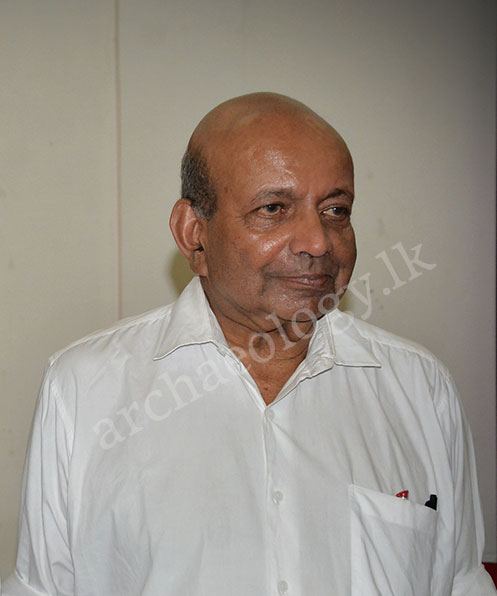It is no easy task to pen down few words on the life history of a colossus like Dr. Siran Deraniyagala, but nevertheless, I will try. Life has its ways, its own twists and turns at times one would not expect; such was the shocking yet inevitable demise of Dr. Deraniyagala. The mystery of life will take us on many paths, and in the case of Dr. Deraniyagala, it took him to explore the mystery of life itself! While digging the earth to unravel humanityÔÇÖs origins, perhaps he too realized where his journey would end, in the earth; and it eventually did come to pass on the 5th of October 2021. The Man who studied the past, of the lifeways of past peoples, now himself joined them; Siran Upendra Deraniyagala is now a person of the past! But what of his legacy? Will he be only a person of the past or will he be remembered in the present? Unlike the mystery of life, this is an easy question with a simple answer. Yes. Siran Deraniyagala will live on! Decades later even after fading from living memory, his name will be remembered even centuries on. Such is his legacy. Therefore let us briefly marvel at the amazing life of Dr. Siran Deraniyagala.

Deshabandhu Dr. Siran Upendra Deraniyagala was a former Director-General of the Department of Archaeology of Sri Lanka but is most well known for being the architect of scientific archaeology and modern Prehistoric research in Sri Lanka. He is one of the most distinguished prehistorians of South Asia having given emphasis and direction to the study of prehistory for the region and also for guiding and training a large cohort of field archaeologists. Born on the 1st of March 1942, he was the third son of the famous Dr. Paulus Edward Pieris Deraniyagala, Director of National Museums and Sri LankaÔÇÖs foremost naturalist and Mrs. Prini Eknaligoda Molamure. He is also the paternal grandson of renowned historian Sir Deraniyagala Paulus Edward Pieris Samarasinghe Sriwardhana, more widely known as Paul E. Pieris.
Siran Deraniyagala was an Old Boy of St. Thomas College, first at St. ThomasÔÇÖs Preparatory School Kollupitiya, followed by its branches in Bandarawela and Gurutalawa and finally at Mt Lavinia. He completed his GCE Advance Levels in London and entered Trinity College of Cambridge University at age 17. He completed is BA in Architecture and Sanskrit in 1963 and on the advice of Sir Max Mallowan and Sir Mortimer Wheeler, he enrolled at the Institute of Archaeology in London (now University College London) under the guidance of Professors Kenneth de Burgh Codrington and Frederick Zeuner. This diploma moulded his research skills including an emphasis on the environment, which formed the backbone of his later research. He completed the diploma in 1965 and his MA from Cambridge University in 1966.
His return to Ceylon was overland which included a stopover in India for a year as a guest of reputed institutions in order to gain first hand experience on the prehistoric and protohistoric materials of South Asia. His real entry into archaeology came next when he joined the Archaeological Survey of Ceylon (as it was known then) as the departmentsÔÇÖ first Assistant Commissioner of the newly established Excavation Branch, when Dr. Raja de Silva (1967-1979) was the Commissioner. Deraniyagala focused the Excavation Branch on research while the Architectural Conservation Branch undertook the more historical archaeology related conservation under then Mr. Roland Silva. While forming a close bond with Roland Silva as Assistant Commissioners of the two branches, their friendship interestingly ran all the way to 1958 London when the young Deraniyagala was sitting for his Advance Levels and the young Roland Silva was studying Architecture.
Ever the far thinker, the young Deraniyagala sat back and first evaluated the entire archaeological scene. While being influenced to follow prehistory from his father, he nevertheless saw its gaps and great potential. Eager to put his western trained scientific background to the test, he identified thematic problems and came up with a multi-stage research design for the prehistoric investigations of Sri Lanka. These investigations were conducted in V stages.
Stage I comprised the synthesising of previous research and probl├®matique
Stage II, the undertaking of spot-surveys indicated by Stage I
Stage III, problem ÔÇôorientated excavation of sites highlighted in the previous stage
Stage IV, synthesis and publication of results of preceding stages
Stage V, the formulation of a fresh probl├®matique to be addressed
Stage I comprised a set of probes namely on the ancient Citadel of Anuradhapura and the open air site of Bellan-bendi Palassa. Anuradhapura was first, and his mentor Prof. K. de B. Codrington guided the initial field seasons in 1969 with the then 28 year old Deraniyagala as field director. The investigation into the earliest habitation levels established a stratigraphic sequence for the Iron Age and Early Historic periods and also the formulation of pottery and bead typologies. The resultant excavation report published in Ancient Ceylon No. 2 (1972) was a landmark in Sri Lankan archaeology with recognition and praise from international scholars as well. This 1969 Anuradhapura Citadel excavation has since gone down in archaeological history in Sri Lanka as it saw the introduction of problem-oriented archaeological research; it is rightfully called the beginning of the modern period of Archaeology in Sri Lanka and is a story told well to all archaeology students. Stage II focused on spot survey of sites throughout the island. These survey resulted in the selection of the ancient coastal Red Earths and their gravels (Iranamadu Formation) for intensive study where three sites around Bundala were subjected to excavation as part of Stage III.
In 1973 Deraniyagala took another step in his career by taking up a five year Doctoral Fellowship at Harvard University. The genius of Deraniyagala is that he gained admittance for doctoral studies to both Cambridge and Harvard Universities. During his five years at Harvard from 1973 to 1978 he had almost individual supervision under the renowned prehistorian Prof. H. L. Movius and also took part in excavations in France and the Netherlands. He further took summer studies at Cambridge University to gain access to South Asia specific information, particularly concerning environments.
Returning to Sri Lanka in 1978, and parallel with Stage IV, Siran Deraniyagala embarked on Stage V of the research design, with systematic excavations of prehistoric rockshelters of the Wet Zone from 1979 to 1986.  He received his doctorate upon submitting his thesis as part of Stage IV which was synthesisation, in 1988. The resultant dissertation, The Prehistory of Sri Lanka: an Ecological Perspective, was a landmark publication and is a go-to reference for South Asian prehistory.
Deraniyagala┬á resigned from his post of Assistant Commissioner (Excavations) in 1983 due to family commitments, but was subsequently appointed as a Consultant to the Department of Archaeology. Having been freed from┬á the daily chores of public office, he focused his attention to research more deeply. Seeing that Stage V of his research design was in good hands under his ÔÇÿstudentsÔÇÖ whom he mentored in the department, he moved from mainstream prehistory to the Protohistoric period or the Early Iron Age, which had been hardly touched upon. This led him back to his place of baptism as a professional archaeologist, the Citadel of Anuradhapura. These would prove some of his most ground breaking research, as would be seen below.
Having served as the first Assistant Commissioner (Excavations) of the Department of Archaeology from 1968-1983 and then as a Consultant to the department, in 1992 he was appointed the Director-General succeeding Mr. M. H. Sirisoma, who had passed away while holding office. He lead the Department of Archaeology until 2001 when he retired from Public service. As the head of the apex institution in-charge of managing the countryÔÇÖs vast archaeological heritage, his time as a researcher was over however, using his visionary approach he immediately set about revamping the administrative aspects of the department as well as the overall heritage management. Amoung his achievements in this capacity, were the creation of a new post of Additional Director-General (Administration) to be responsible for the day to day functioning of the Department, a documentation and inventorization programme of sites and monuments, and most importantly a much-needed amendment to the Antiquities Ordinance Act of 1940.┬á The formulation of the National Archaeological Policy was yet another milestone which he considered was the apex of his career; when in 2005 the Minister for Cultural Affairs appointed him chairman of the committee to draft the National Archaeological Policy, which he had initially formulated while serving as the Director-General. This milestone document was adopted by the Government in 2006 and constitutes perhaps the only national archaeological policy to have been formulated anywhere in Asia.
The visionary and holistic approach of Deraniyagala to archaeological inquiry gained him a reputation as a rigorous and trailblazing scholar. While still being in his 20s, he took up the position of Assistant Commissioner (Excavation), he surveyed the prehistoric archaeological scene of Sri Lanka and identified the following problems (a) absence of a chronological framework to which prehistoric assemblages could be referred, even tentatively, (b) lack of a cohesive palaeo-environmental history, (c) ignorance on human/environment interactions, with particular reference to subsistence strategies, and (d) lack of placement of Sri LankaÔÇÖs prehistory within the context of South Asian and world prehistory. This directly led to his formulation of the five-stage research design for prehistoric research in Sri Lanka. His contributions to the prehistory of Sri Lanka would suffice a work of its own, but the most revolutionary are; the confirmation of the existence of a Middle Stone Age (Middle Palaeolithic) in Sri Lanka; providing vital information on┬á Pleistocene climate changes in South Asia through the investigations into the Iranamadu Formation; the dating of the Microlithic Age to over 30,000 years BP which totally revolutionised the internationally accepted ceiling of c. 12,000 BP for the appearance of microlithic technology outside Africa; and the discovery of the earliest anatomically modern humans in South Asia from the Fa Hien-lena cave in 1986.
His research at Anuradhapura into the early occupational layers of the site were ground breaking on its own and could also be argued as his most significant findings. The earliest occupational layers were correlated to the Early Iron Age at the citadel of Anuradhapura, giving a date ca.900 BCE and remarkably establishing the rise of urbanism at the site from ca.700 BCE, some 400 years earlier than as stated in the historical chronicles. In comparison with India, during the 3rd century BCE the Citadel of Anuradhapura was estimated to be the largest citadel south of Ujjain in North India. Another significant milestone was the dating of the Brahmi script at Anuradhapura to ca.600 BCE, which until then had been dated to not earlier than  the 3rd century BCE. These dates have since been corroborated by excavations at Kodumanal and Porunthal in South India and at Andarawewa to the west of Anuradhapura. This moved the age-boundary between the protohistoric and Early Historic periods as the 6th century BCE and not the 3rd century BCE in South Asia.
The illustrious career of Dr. Deraniyagala is too large to cover for such an article, nevertheless, some salient snippets are him being a Reviewer for articles to Current Anthropology and for National Geographic Society grant proposals, and of the following appointments: Fellow of the American Archaeological Association (1991), Fellow of the National Academy of Sciences of Sri Lanka (1991), Corresponding Member of the German Archaeological Institute (1995). Member of the Permanent Council of the Union International des Sciences Prehistoriques et Protohistoriques (1996), Honorary Life President of the United Nations Association of Sri Lanka (1997), Vice President of the ICOMOS Sri Lanka (1998-1999), President of the Sri Lanka Council of Archaeologists (1998-2002). Honorary DSc of Sabaragamuwa University (1999), Honorary DLitt of Peradeniva University (2001), Gold Medal of the Sri Lanka Council of Archaeologists (2004), and designated Deshabandhu in the national honours list by the President of Sri Lanka (2005).
Another hallmark of Dr. Deraniyagala was his focus on training and human resource development, such as the grooming of the younger generation of archaeologists and guiding them to their doctorates. This he continued till his last days, as a grand sage mentoring the current and future archaeologists in matters of career, research and policy. Indeed the loss of Dr. Deraniyagala will be felt but his legacy will live on.
(Information for this article is taken with kind permission from notes of Dr. Nimal Perera, Mr. Anuradha Piyadasa, and autobiographical notes from the legend himself)
Chryshane Mendis


